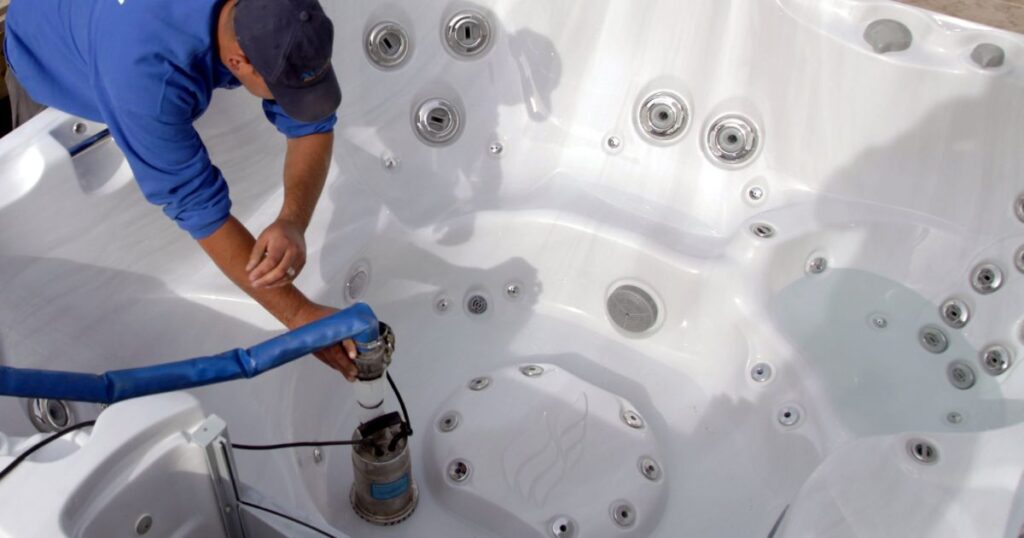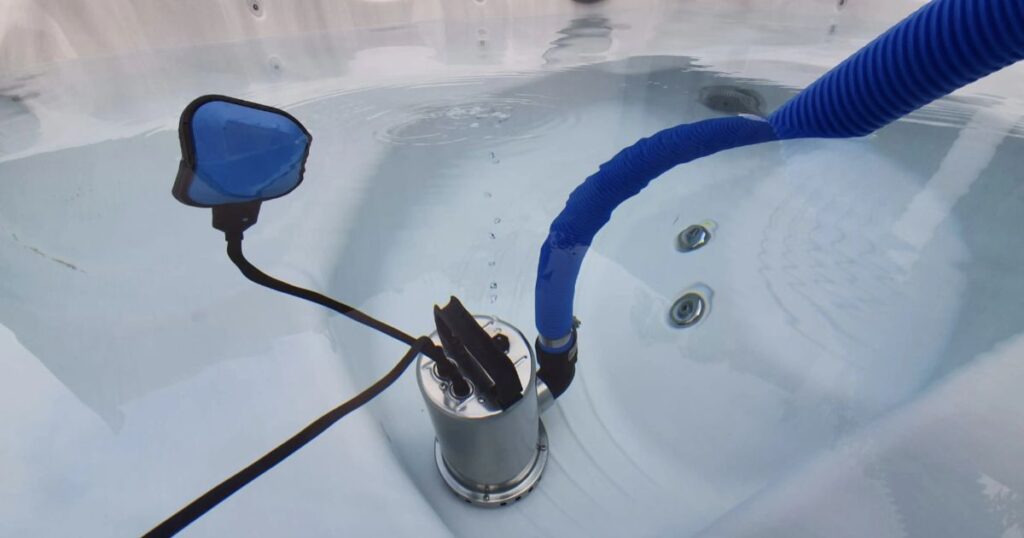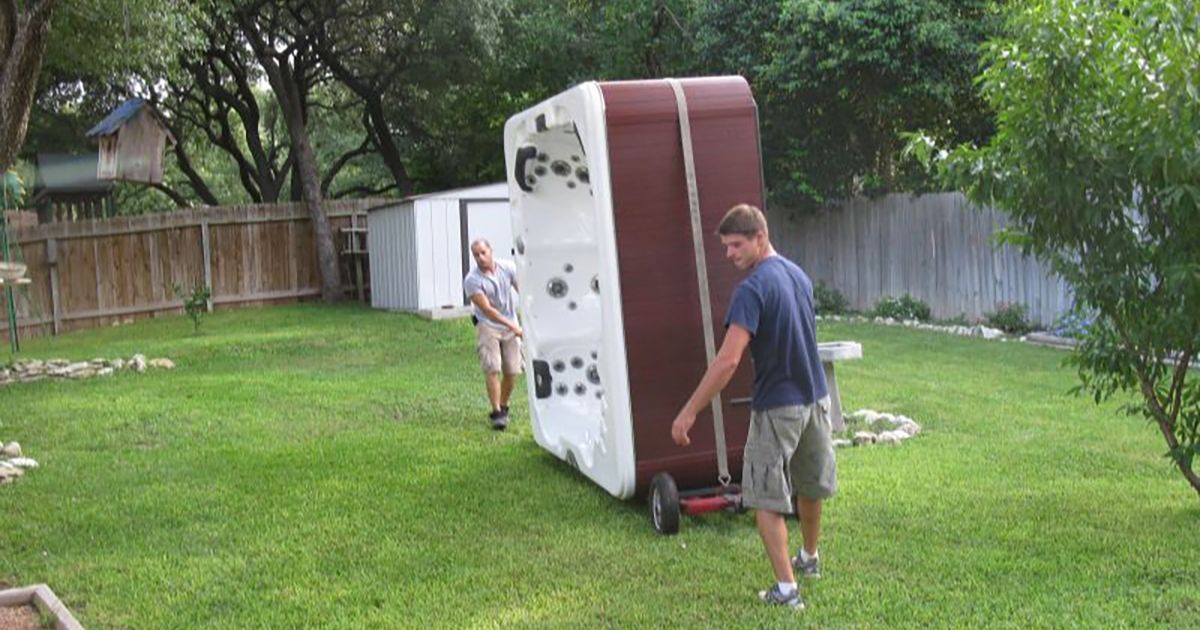Moving a hot tub can be a daunting task, requiring meticulous planning and careful execution. Whether you’re relocating to a new home or rearranging your outdoor space, knowing how to move a hot tub efficiently is crucial to prevent damage and ensure a smooth transition. The process involves several steps, from preparing the tub for transport to safely loading, transporting, and reinstalling it at its new location. Prioritizing safety is paramount, as hot tubs are heavy and unwieldy objects that demand proper equipment, manpower, and technique.
Additionally, understanding the logistics, such as measuring doorways and pathways, is vital for a successful move. This guide provides comprehensive insights, step-by-step instructions, and essential tips to help navigate this challenging task, ensuring your hot tub relocation is accomplished with minimal stress and maximum care.
Preparing for the Move
Preparing for the move involves several essential steps to ensure a smooth and safe transition for your hot tub:
Assessing Accessibility
Assessing accessibility involves measuring doorways, passages, and the destination area to guarantee the hot tub’s smooth passage. This step ensures the tub’s dimensions align with the available space, preventing potential obstacles or damage during the move. By measuring entry points, hallways, and any potential tight corners, you can plan the most efficient route and determine if any modifications or disassembly are necessary for safe relocation. This proactive approach minimizes surprises on moving day, allowing for adjustments or arrangements to accommodate the hot tub’s size and shape, ensuring a hassle-free transfer to its new location.
Gathering Supplies
Gathering supplies for moving a hot tub involves acquiring essential equipment to facilitate a safe and efficient relocation. Items such as sturdy moving straps, a heavy-duty dolly or cart, blankets or padding for protection, and tools for disconnecting electrical and plumbing connections are crucial.
Additionally, having plywood sheets or boards to create a smooth pathway, waterproof tarps for covering the hot tub during transport, and cleaning supplies for post-move maintenance can further aid in a successful transition. These supplies are integral for safeguarding the hot tub from damage and ensuring a well-prepared move to its new location.
Draining the Hot Tub

Draining the hot tub is a crucial step before moving it. Begin by turning off the power and water supply to the tub. Utilize the drainage valve or pump, following the manufacturer’s instructions, to completely empty the tub. Ensure all water is expelled, including from any hidden plumbing or jet systems.
Once drained, use towels or a wet/dry vacuum to remove any remaining moisture, ensuring the interior is dry. This step not only reduces the weight for transport but also prevents water spillage during the move, safeguarding the tub and its surroundings from potential damage.
Disconnecting Utilities
Moving a hot tub requires meticulous planning and preparation. Start by assessing the pathway and destination for accessibility. Gather necessary tools like moving straps and a dolly. Drain the tub completely, disconnect electrical and plumbing connections, and protect fragile parts. Enlist help for the heavy lifting and ensure everyone knows their role. Safely load the tub onto a truck or trailer, securing it with straps.
Upon arrival, carefully unload and reinstall, reconnecting utilities as per manufacturer instructions. Prioritize safety throughout the process to prevent damage and ensure a successful, stress-free relocation of your hot tub.
Securing permits or permissions
Securing permits or permissions is crucial when moving a hot tub, especially if transporting it through public areas or using professional movers. Check local regulations as some areas require permits for oversized loads or transportation of heavy equipment. Obtaining these permits ensures compliance with local laws, prevents potential fines, and helps plan for any necessary road closures or accommodations.
Professional movers often handle permit logistics, but if moving independently, contact local authorities or the transportation department to acquire the required permissions. Prioritizing this step avoids legal issues and ensures a smooth, lawful relocation process for your hot tub.
Organizing Assistance
Organizing assistance is crucial when moving a hot tub due to its weight and complexity. Engaging friends, family, or professional movers ensures a safer and more efficient process. Distributing tasks among the team—such as lifting, guiding, or overseeing—divides the workload and minimizes the risk of injury.
Experienced helpers can offer insights and strategies, enhancing the move’s success. Communicating a clear plan beforehand ensures everyone understands their roles, fostering a coordinated effort. Working together streamlines the process, making it more manageable and reducing the chances of accidents or damage to the hot tub.
Protective Measures
Protective measures are crucial when moving a hot tub. Cover delicate parts like jets and controls with thick blankets or padding to shield them from bumps and scratches during transport. Secure these covers tightly using straps or ropes to prevent slippage.
Additionally, consider wrapping the entire hot tub with a weatherproof tarp to shield it from the elements, especially if moving long distances. These protective layers not only safeguard the hot tub’s components but also act as a barrier against dust, debris, and potential damage, ensuring your hot tub arrives at its new location in optimal condition.
Creating a Plan
Creating a plan for moving your hot tub is pivotal for a seamless relocation. Start by mapping out the entire process, detailing each step from disconnection to reinstallation. Assign specific tasks to individuals involved, ensuring everyone comprehends their role on moving day. Consider the logistics: measure doorways, pathways, and the final location, establishing the safest route for transportation.
Factor in any special equipment needed and plan for contingencies, such as unforeseen obstacles or weather conditions. A well-structured plan mitigates confusion, minimizes risks, and facilitates a coordinated effort, ensuring the hot tub’s safe and efficient transfer to its new home.
Gathering Necessary Supplies and Equipment
Gathering the necessary supplies and equipment is pivotal for a successful hot tub move. Essential items include:
Moving Straps: Sturdy straps to secure the hot tub during transport and lifting.
Dolly or Hand Truck: A reliable dolly to maneuver the heavy tub, aiding in its movement.
Blankets or Padding: Protective covering to shield delicate parts from scratches or impact.
Tools: Wrenches, screwdrivers, and other tools required to disconnect plumbing and electrical connections.
Tarp or Plastic Sheet: To cover the hot tub and protect it from dirt, debris, or adverse weather conditions.
Personal Protective Equipment (PPE): Gloves and sturdy footwear for safety during the lifting and moving process.
Having these supplies on hand ensures a smoother and safer hot tub relocation, reducing the risk of damage and simplifying the overall process.
Securing Professional Help or Assistance
Securing professional help or assistance is a wise step when moving a hot tub, particularly if you lack experience or the necessary equipment for a safe relocation. Consider hiring a moving company with expertise in handling bulky items. These professionals possess the right tools, such as specialized dollies and lifting equipment, ensuring a smoother and safer transfer.
Moreover, their experience minimizes the risk of damage to the hot tub and surrounding areas. Before hiring, verify the company’s insurance coverage and reputation to guarantee a reliable and secure move. Professional movers bring expertise and efficiency to the process, relieving the stress and physical strain associated with relocating a heavy and cumbersome item like a hot tub.
Disconnecting and Draining the Hot Tub

Disconnecting and draining the hot tub is a critical step in preparing it for a move. Start by turning off the power supply to avoid any electrical hazards. Then, follow the manufacturer’s guidelines to safely disconnect the electrical and plumbing connections.
This typically involves shutting off the circuit breaker, disconnecting the power source, and draining the water. Use a submersible pump or a designated drain valve to completely empty the hot tub.
Ensure all water is removed from the pipes, jets, and internal components to prevent damage and reduce the overall weight for easier transportation. Once drained, let the hot tub dry thoroughly to avoid any potential moisture-related issues during the move.
Measuring and Clearing the Pathway
Measuring and clearing the pathway is a crucial step when preparing to move a hot tub. Start by measuring the hot tub’s dimensions and comparing them to doorways, corridors, and any tight spaces along the route to the new location.
Ensure that there’s enough clearance and space for the hot tub to pass through without getting stuck or causing damage. Clear the pathway by removing any obstacles like furniture, plants, or debris that could obstruct the movement of the hot tub. Outdoor spaces might require trimming bushes or temporarily relocating objects to create a clear and obstacle-free path. This meticulous preparation helps prevent potential issues during the actual move, ensuring a smoother and safer relocation for the hot tub.
Using Proper Lifting Techniques
Using proper lifting techniques is crucial when moving a hot tub to prevent injuries and ensure safe handling. Start by assembling a team of individuals to help with the lifting, ensuring everyone is aware of the plan and their role in the process. Before lifting, ensure you have the appropriate lifting equipment, such as sturdy straps or a moving dolly. When lifting, bend at the knees and use your legs rather than your back to lift the hot tub.
Maintain a straight back, secure grip, and communicate clearly with your team to coordinate movements. Lift in unison and move slowly and steadily, avoiding sudden jerks or twists that could strain muscles or cause accidents. Prioritize safety and take breaks when needed to avoid fatigue, ensuring a smooth and injury-free lifting process.
Loading the Hot Tub Safely
Loading the hot tub safely is crucial to prevent damage and ensure a smooth transition to its new location. Start by positioning a sturdy ramp or lift near the hot tub’s exit point to facilitate loading onto the transportation vehicle. Use proper lifting techniques, utilizing straps or a moving dolly to carefully guide the hot tub onto the ramp or lift.
Ensure the hot tub is centered and balanced to prevent tipping or shifting during the loading process. If using a truck or trailer, secure the hot tub with straps or tie-downs to keep it stable during transportation. Double-check that the hot tub is firmly secured and won’t move or slide while in transit. Prioritize safety at every step to guarantee the hot tub reaches its destination without any damage.
Transporting the Hot Tub
Transporting a hot tub requires careful planning and consideration to ensure its safety and integrity during the journey. Begin by choosing an appropriate vehicle capable of accommodating the hot tub’s size and weight. Use a flatbed trailer, truck with a liftgate, or a professional moving truck specifically designed for transporting heavy items.
Secure the hot tub firmly on the vehicle using straps, tie-downs, or fasteners to prevent shifting or movement during transit. Ensure the hot tub is centered and balanced to distribute weight evenly. Drive cautiously, avoiding sudden stops, sharp turns, and rough roads to minimize jostling and potential damage.
If moving over long distances, periodically check the hot tub’s restraints and the vehicle’s stability. Account for weather conditions and consider covering the hot tub with a weatherproof tarp to shield it from elements like rain, wind, or debris.
Prioritize a smooth and steady journey to safeguard the hot tub and ensure it arrives at its new location in optimal condition.
Unloading and Placement at the New Location
Upon reaching the new location, carefully unload the hot tub using proper equipment and a designated pathway. Ensure the destination area is clear and prepared for the hot tub’s placement. Use a ramp or liftgate to lower the hot tub from the transportation vehicle, employing caution and proper lifting techniques to avoid damage.
Position the hot tub according to the pre-planned location, considering factors like ground level, stability, and access to utilities if applicable. Utilize lifting straps or a dolly to guide the hot tub to its designated spot, ensuring a smooth and controlled movement.
Once in place, double-check the hot tub’s alignment and stability. Reconnect any necessary electrical or plumbing connections following manufacturer guidelines. Take time to level the hot tub properly, ensuring it sits evenly on its base.
Prioritize safety and precision during this process to prevent damage to the hot tub or surrounding areas, ensuring a successful and secure placement at its new home.
Reconnecting and Refilling the Hot Tub
Reconnecting and refilling the hot tub is a critical step post-relocation. Begin by reconnecting the electrical and plumbing components according to the manufacturer’s instructions. Ensure all connections are secure, and if needed, seek professional assistance to guarantee proper reinstallation.
Next, slowly refill the hot tub with water, monitoring the process to prevent overflow. Take care to add the appropriate chemicals based on the hot tub’s specifications to maintain water quality.
Once filled, power up the hot tub and test its functionality, including heating, jets, and any additional features. Allow the hot tub to run for a sufficient time to ensure everything is working correctly.
Conduct a final inspection to ensure there are no leaks or issues arising from the reconnection and refilling process. Prioritize safety and accuracy to ensure the hot tub is fully operational and ready for use in its new location.
Testing and Ensuring Proper Functionality
Testing and ensuring proper functionality is crucial after relocating a hot tub. Begin by checking all electrical connections to ensure they’re securely reattached and in proper working order. Turn on the power and test each component, including the jets, lights, heater, and control panel, to ensure they function correctly.
Run the hot tub through a complete cycle, allowing the water to heat up to the desired temperature. Monitor the system for any unusual noises, leaks, or malfunctions during this testing phase.
Check the water quality by using appropriate testing kits to ensure the chemical balance meets recommended levels for safe and enjoyable use. Adjust chemicals as necessary to maintain proper balance and water clarity.
Finally, invite a professional or someone familiar with hot tub maintenance to perform a comprehensive inspection if any concerns arise. This meticulous testing process guarantees that the hot tub is fully operational, safe, and ready for use in its new location.
Post-Move Maintenance and Care
Post-move maintenance and care are essential to ensure your hot tub remains in optimal condition after relocation. Start by regularly inspecting the hot tub for any signs of damage, leaks, or issues that may have arisen during the move. Address any concerns promptly to prevent potential problems from escalating.
Continue with routine maintenance tasks, such as cleaning the filters, to maintain proper water quality and circulation. Follow the manufacturer’s guidelines for maintenance schedules, including water testing, chemical balancing, and cleaning the hot tub surfaces.
Inspect the hot tub cover for any damage and ensure it fits snugly to maintain insulation and protect the hot tub from debris.
Consider scheduling a professional service or maintenance check-up after the move to ensure everything is functioning correctly and to address any lingering concerns.
By prioritizing ongoing maintenance and care, you’ll prolong the lifespan of your hot tub and ensure a consistently enjoyable and relaxing experience for years to come.
Pros and Cons
Certainly, here’s a chart outlining the pros and cons of moving a hot tub:
| Pros | Cons |
| 1. Customization: Moving a hot tub allows you to position it in a preferred location, enhancing your outdoor space. | 1. Complexity: Moving a hot tub involves intricate logistics, potentially requiring professional assistance. |
| 2. Optimized Space: Re-positioning a hot tub can optimize space or accommodate new landscaping in your backyard. | 2. Cost: Professional moving services or equipment rental for relocation can be expensive. |
| 3. Renewal: Transporting a hot tub can present an opportunity to perform maintenance or upgrade the unit. | 3. Risk of Damage: Improper handling during transportation may cause damage to the hot tub or surrounding property. |
| 4. Change of Scenery: Moving the hot tub can offer a fresh perspective or change of scenery, enhancing your relaxation experience. | 4. Time-Consuming: The process of disassembling, moving, and reassembling a hot tub is time-intensive. |
| 5. Flexibility: Moving a hot tub allows flexibility for those relocating homes, ensuring you can take it with you to a new residence. | 5. Safety Concerns: There are potential safety risks involved in lifting heavy objects, requiring proper precautions and equipment. |
FAQ’s
What is the easiest way to move a hot tub?
After you turn off the breaker, and disconnect the wiring and plumbing, you turn the hot tub on its side. Then, you tip the tub and roll in a furniture dolly, or two furniture dollies. You set the tub back down on the dolly/dollies. Roll the tub to the trailer, tip it onto the trailer and strap it down for the trip.
Are hot tubs hard to move?
We repeat: Do not try to move your hot tub alone. It’s way too heavy for one — or even two people — to handle. You’ll need at least four (but more like six) able-bodied helpers. If you can’t source enough people for your team, consider getting professional packing and loading assistance.
How heavy is a 6 person hot tub?
Larger hot tubs meant to accommodate six to seven or eight or more people typically have an empty weight of anywhere between 600 lbs. to 900 lbs. and a filled weight of 4,000 lbs. or more.
How heavy is a spa pool?
A Spa Pool can weigh between 1-3 tonne when filled with water and therefor requires a sturdy foundation. This needs to be a flat, level surface that supports the entire weight and can handle water spillage.
How heavy is a hot tub in KG?
You can expect a small hot tub to weigh about 1,400kg all in and the very largest spas to come in at around 3,000kg in total.
Conclusion
Moving a hot tub demands meticulous planning, careful execution, and a keen focus on safety at every stage. From disconnecting and draining to loading, transporting, and reinstallation, each step requires attention to detail and proper technique. Preparing the pathway, using proper lifting methods, and securing professional help when needed are pivotal for a smooth relocation.
The process doesn’t end once the hot tub reaches its new location; reconnecting utilities, testing functionality, and post-move maintenance—including how to clean a hot tub—ensure its continued performance. Prioritizing precision and care throughout this process safeguards the hot tub against damage and ensures its longevity. Remember, patience and adherence to manufacturer guidelines are key. By following these steps diligently, you not only ensure a successful move but also guarantee many more relaxing moments in your rejuvenated hot tub oasis.








